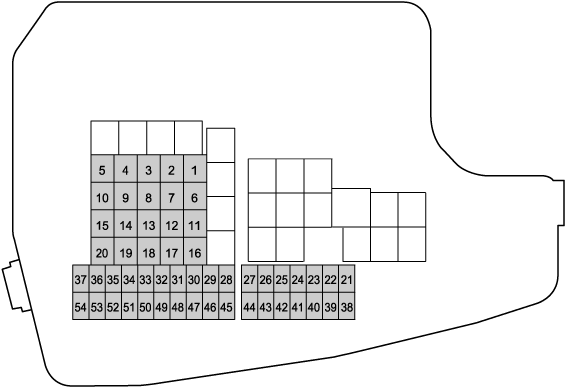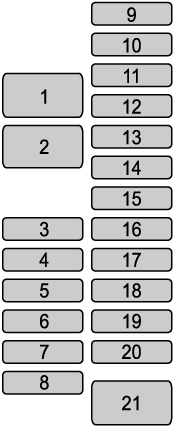Fuse Panel Description
Fuse block (Engine compartment)

|
DESCRIPTION |
FUSE RATING |
PROTECTED COMPONENT |
|
|---|---|---|---|
|
1 |
ADD FAN GE |
30 A |
Cooling fan (Some Models) |
|
2 |
IG2 |
30 A |
For protection of various circuits |
|
3 |
INJECTOR |
30 A |
Engine control system (Some Models) |
|
4 |
FAN DE |
40 A |
Cooling fan (Some Models) |
|
5 |
P.WINDOW1 |
30 A |
Power windows (Some Models) |
|
6 |
― |
― |
― |
|
7 |
ADD FAN DE |
40 A |
Cooling fan (Some Models) |
|
8 |
EVVT |
20 A |
Engine control system (Some Models) |
|
9 |
DEFOG |
40 A |
Rear window defogger |
|
10 |
DCDC DE |
40 A |
For protection of various circuits (Some Models) |
|
11 |
FAN GE |
30 A |
Cooling fan (Some Models) |
|
12 |
EPB L |
20 A |
Electric parking brake (LH) |
|
13 |
AUDIO |
40 A |
― |
|
14 |
EPB R |
20 A |
Electric parking brake (RH) |
|
15 |
ENG.MAIN |
40 A |
Engine control system |
|
16 |
ABS/DSC M |
50 A |
ABS, Dynamic stability control system |
|
17 |
 |
50 A |
For protection of various circuits |
|
18 |
WIPER |
20 A |
Front window wiper and washer |
|
19 |
HEATER |
40 A |
Air conditioner |
|
20 |
DCDC REG |
30 A |
For protection of various circuits (Some Models) |
|
21 |
ENGINE.IG1 |
7.5 A |
Engine control system |
|
22 |
C/U IG1 |
15 A |
For protection of various circuits |
|
23 |
H/L LOW L HID L |
15 A |
Headlight low beam (LH) |
|
24 |
H/L LOW R |
15 A |
Headlight low beam (RH) |
|
25 |
ENGINE3 |
15 A |
Engine control system |
|
26 |
ENGINE2 |
15 A |
Engine control system |
|
27 |
ENGINE1 |
15 A |
Engine control system |
|
28 |
AT |
15 A |
Transaxle control system (Some Models), Ignition switch |
|
29 |
H/CLEAN |
20 A |
Headlight washer (Some Models) |
|
30 |
A/C |
7.5 A |
Air conditioner |
|
31 |
AT PUMP |
15 A |
Transaxle control system (Some Models) |
|
32 |
STOP |
10 A |
Brake lights |
|
33 |
R.WIPER |
15 A |
Rear window wiper (Some Models) |
|
34 |
H/L HI |
20 A |
Headlight high beam |
|
35 |
HID R |
15 A |
― |
|
36 |
FOG |
15 A |
Fog lights (Some Models) |
|
37 |
 |
7.5 A |
Engine control system |
|
38 |
AUDIO2 |
7.5 A |
Audio system |
|
39 |
GLOW SIG |
5 A |
Engine control system (Some Models) |
|
40 |
METER2 |
7.5 A |
Instrument cluster |
|
41 |
METER1 |
10 A |
Instrument cluster |
|
42 |
SRS1 |
7.5 A |
Air bag |
|
43 |
BOSE |
25 A |
Bose® Sound System-equipped model (Some Models) |
|
44 |
AUDIO1 |
15 A |
Audio system |
|
45 |
ABS/DSC S |
30 A |
ABS, Dynamic stability control system |
|
46 |
FUEL PUMP |
15 A |
Fuel system (Some Models) |
|
47 |
FUEL WARM |
25 A |
― |
|
48 |
TAIL |
15 A |
Tail lights, Number plate lights |
|
49 |
FUEL PUMP2 |
25 A |
― |
|
50 |
HAZARD |
25 A |
Hazard warning flashers, Direction indicator lights |
|
51 |
DRL |
15 A |
― |
|
52 |
R.OUTLET2 |
15 A |
Accessory sockets |
|
53 |
HORN |
15 A |
Horn |
|
54 |
ROOM |
15 A |
Overhead light |
Fuse block (Left side)

|
DESCRIPTION |
FUSE RATING |
PROTECTED COMPONENT |
|
|---|---|---|---|
|
1 |
P.SEAT D |
30 A |
Power seat (Some Models) |
|
2 |
P.WINDOW3 |
30 A |
Power windows |
|
3 |
R.OUTLET3 |
15 A |
― |
|
4 |
P.WINDOW2 |
25 A |
Power windows |
|
5 |
SRS2/ESCL |
15 A |
Electronic steering lock |
|
6 |
D.LOCK |
25 A |
Power door locks |
|
7 |
SEAT WARM |
20 A |
Seat warmer (Some Models) |
|
8 |
SUNROOF |
10 A |
Sunroof (Some Models) |
|
9 |
F.OUTLET |
15 A |
Accessory sockets |
|
10 |
MIRROR |
7.5 A |
Power control mirror |
|
11 |
R.OUTLET1 |
15 A |
Accessory sockets (Some Models) |
|
12 |
― |
― |
― |
|
13 |
― |
― |
― |
|
14 |
― |
― |
― |
|
15 |
― |
― |
― |
|
16 |
― |
― |
― |
|
17 |
M.DEF |
7.5 A |
Mirror defogger (Some Models) |
|
18 |
R.SEAT W |
20 A |
Seat warmer (Some Models) |
|
19 |
R.SHADE |
7.5 A |
― |
|
20 |
AT IND |
7.5 A |
AT shift indicator |
|
21 |
P.SEAT P |
30 A |
Power seat (Some Models) |


 Read this first
Read this first



















